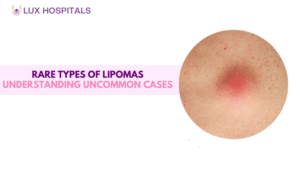10 Common Causes of Breast Lumps You Should Know

Finding a lump in your breast can be a stressful experience. However, not all breast lumps are dangerous, many are harmless and caused by regular bodily changes. Understanding the possible causes of breast lumps can help ease anxiety and guide you toward the proper medical care. Breast lumps can be a concerning discovery, but not all lumps are harmful.
Understanding the potential causes is crucial for your peace of mind and overall breast health. Here are 10 common causes of breast lumps you should be aware of:
Causes of Breast Lumps
1. Fibroadenomas
One of the most prevalent benign (non-cancerous) breast fibroadenomas is malignant. Lumps. They often occur in women aged 15–35. These lumps are
- Smooth, firm, and rubbery
- Moveable under the skin
- Usually painless
They don’t typically require treatment unless they grow or cause discomfort.
2. Breast Cysts
Cysts are fluid-filled sacs that develop due to hormonal fluctuations. They may:
- Feel soft or firm
- Be round and movable.
- Become tender before menstruation.
Cysts are common in women over 35 and may go away on their own or be drained if painful.
3. Fibrocystic Breast Changes
This condition is caused by hormonal changes during the menstrual cycle, leading to:
- Lumpy, tender breast tissue
- Swelling and discomfort
- Symptoms that worsen before your period
Although uncomfortable, fibrocystic changes are benign and do not increase cancer risk.
4. Breast Infections (Mastitis)
Infections are common during breastfeeding and may cause lumps due to inflamed or blocked milk ducts. Symptoms of breast lumps include:
- Pain, redness, and warmth
- Fever or flu-like symptoms
- A complex, swollen area
Mastitis is usually treated with antibiotics and rest.
5. Fat Necrosis
Fat necrosis occurs when fatty breast tissue is damaged, usually after surgery or trauma. The result is a firm, painless lump that may:
- Mimic cancer on imaging.
- Feel round or irregular.
- Sometimes, it can be accompanied by skin dimpling.
A biopsy may be needed to confirm the diagnosis.
6. Lipomas
Lipomas are soft, non-cancerous lumps made of fatty tissue. They are:
- Usually painless
- Slow-growing
- Often found just under the skin.
They rarely require treatment unless they become bothersome.
7. Abscesses
An abscess is a painful lump filled with pus, often caused by an infection. Signs include:
- Red, swollen, tender area
- Fever and fatigue
- Warmth around the lump
Medical drainage and antibiotics are usually needed.
8. Breast Injury or Trauma
An injury to the breast can cause bruising and lump formation due to internal bleeding or fat necrosis. While these lumps are not cancerous, they should be monitored for changes.
9. Hormonal Changes
Hormones can cause temporary lumpiness, especially before menstruation or during puberty, pregnancy, and menopause. These lumps usually resolve independently and are linked to natural hormonal shifts.
10. Breast Cancer
While most breast lumps are benign, some may be cancerous. A cancerous lump may:
- Feel stiff, immovable, and irregular
- Be painless or cause discomfort.
- Be accompanied by nipple discharge or skin changes.
Important: Any persistent or unusual lump should be evaluated by a doctor.
When to See a Doctor?
Seek medical attention if you notice:
- A new lump or one that’s growing
- Changes in breast size, shape, or skin texture
- Nipple discharge (especially if bloody)
- Pain or swelling that doesn’t go away
Conclusion
While finding a breast lump can be concerning, it’s not always a sign of cancer. Harmless conditions cause breast lumps and can be easily treated or monitored. Regular breast self-exams and routine screenings like mammograms are essential for early detection and peace of mind. While finding a breast lump can be alarming, it’s necessary to keep in mind that the majority are not malignant. Among the numerous benign reasons are infections, fibroadenomas, cysts, and hormonal changes.
Frequently Asked Questions
Breast lumps can grow due to hormonal fluctuations, fluid buildup (cysts), infections, benign tumors like fibroadenomas, or malignant tumors. Growth may also be influenced by factors like age, genetics, or hormone therapy.
Breast lumps can last anywhere from a few days to several months, depending on the cause. Hormonal lumps may go away after your menstrual cycle, while others, like cysts or fibroadenomas, can persist and may require monitoring or treatment.
To help avoid breast lumps, maintain a healthy lifestyle with a balanced diet, regular exercise, and limited alcohol. Manage stress and hormonal balance, avoid unnecessary hormone therapy, and perform regular breast self-exams to detect any changes early.
Normal breast lumps can include fibrocystic changes (lumpy, tender tissue) and fibroadenomas (benign, movable lumps). However, any new or unusual lump should be evaluated by a doctor to rule out concerns.




















